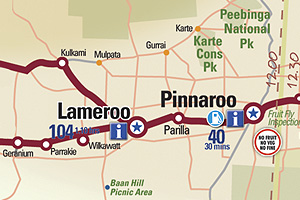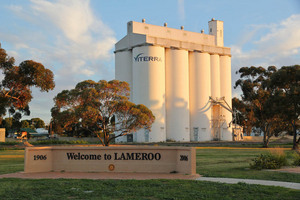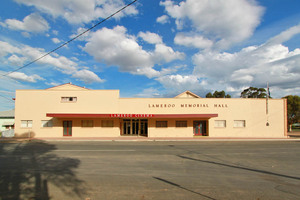
Home of Julie Anthony
It is said that Lameroo township is an oasis in the dry Mallee area. With its abundance of lawned areas, and its tree planting programs in recent years, the description is very apt. It is not surprising to learn that Lameroo was judged winner of the medium sized town category in the 1992 KESAB Tidy Towns Awards, and has been in the top ten towns for five consecutive years. The neat lawned rest areas are popular with travellers passing through, and the public toilets in the main street have earned favourable comments for many years for their cleanliness.
One of the region's major attractions is its peace and tranquility. It is a region that is interesting all year round as the changing seasons show. The colours of the paddocks turn from a reddish brown earth to a vivid green and then to the golden colours of the ripening grain. In spring the region becomes a picture with the many varieties of wildflowers blooming.
Today Lameroo welcomes visitors with lush lawned picnic areas and a children’s playground on the main street. At picturesque Lake Roberts, on the eastern approach to the town, there are alternative picnic areas and the newly opened and well appointed caravan park.
A short but interesting historical trail runs along the railway line behind the Council offices and playground and other longer walking trails start and finish at the craft shop and museum complex. Or take one of the 4 local heritage walks.
The local bakery, café and delis provide welcome refreshments for travellers.
There is an 18 hole golf course open to the public and, in summer, a dip in the local swimming pool is very refreshing.
Baan Hill picnic area is within a short drive of the town.
The Mallee District National Parks and Wildlife SA office is located in the centre of Lameroo’s main street and has information on the various conservation parks, camping grounds and walking trails in the area as well as the Border Track.
LAMEROO HISTORY
Lameroo Town Walks
Walk One | Walk Two | Walk Three | Walk Four
The Memoirs of 'One Son of the Mallee'
By Ted Flohr
In the Beginning - Lameroo
Much of the land around Lameroo was released for pastorial ownership in about 1858. For the first twenty years there were several lessess; the area had limited grazing during this time. Not until one Isabella Baker took over in 1884 were any improvements constructed. The setting up of a station homestead and well at Garra, south of Parrakie, brought added interest to Wow Wow Plain. This area, unique because of its natually rich soil, semi-open woodland, and stands of Southern Cyprus Pine, was of immense value to those people interested in the growing of crops. A well was dug at Wow Wow Plain in 1884. It was 7ft by 4ft in section and 254ft deep and timbered with round Cypress Pine - it was dug by pick and shovel. From these beginnings, settlement on Wow Wow Plain became permanent. The land was surveyed in 1894 and the initial survey of Wow Wow Plain gave each block some natural open land to start cultivating. The town reserve was proclaimed in 1894 and a Government well excavated. A horse operated mechanism was constructed to raise water.
The railway to Tailem Bend was surveyed and constructed. The first trains arrived with passengers and good and the railway declared open on September 8th, 1906, and Lameroo was named. Regular train services brough new settlers aplenty; building materials and machinery came in a steady stream. By the time World War I started in 1914 every surveyed block of land around Lameroo was taken.
The war put a dampner on development for the period. However, once peace again reigned and the soldiers returned, development and land prices surged.
By the late twenties, some farm homesteads were beginning to be much more elaborate and even had some conveniences like running water and flush toilets.
The Great Depression struck in 1930 and almost overnight subsistence living took over. Many farmers had bank overdrafts and those just starting out were struck penniless. Familes walked off their land with only the possessions they could carry. No one during this period had any sign of prosperity. Even as late as the beginning of World War II, 1939, attrition was still taking place.
Peace in 1945 brought renewed optimism. Grain prices soared to unprecidented heights as did wool and stock prices. The 1950s were the most profitable years ever for farming. Since that time, farm costs have steadily increased and the profit margins steadily declined.
The Pain of Drought
No story of Lameroo could possibly be complete without the telling of the times of drought. The first real drought hit in 1914. Because farmers were just starting out, no significant fodder reserves had been built up, newly cleared land grew little or no pasture and green crops grown for horse feed died or achieved little or no growth.
The situation was very soon near disaster. Farmers collected their draught animals together, loaded them onto the train and sent them by rail to ar Hergot Springs (Marree) close to Central Australia for agistment. This drastic journey was necessary because the whole of southern Australia was in drought and no feed was available, even in established farming districts. And so it was that here, the horses stayed, living like wild brunbies until once more rain returned to the Mallee.
The Great Depression was not a rainfall "drought" but a severe drought of money, and went on for some years. To survive, farmers and townsfolk alike had to revert to a system of barter to just exist.
My father had a mail run to the north of the town, only twelve miles, but over unmade dirt tracks. During this period it was a day's work to just complete one run. As well as mail, my father did settlers' shopping. Farmers would leave their boxes of eggs or butter at the gate, plus a shopping order. He would deliver the eggs etc. to the Eudunda Farmers storekeepers. They in turn would exchange the produce for the value of groceries. Every so often when my father's payment was due, farmers would pay with a quarter of a sheep or a few dressed chooks.
A drought of a very different kind occurred in March and April of 1934. Because Lameroo sits above our underground water supply, windmills (wind pumps) were used to draw water to the surface for stock water and pesonal use - windmills paved the way for Mallee agriculture. The period from mid-March to the end of April was almost completely windless; therefor no water. Farmers were soon desperate for stock water.
My father was able to purchase a "pump jack" made by the local blacksmith. This jack could be connected to a windmill, plus the addition of a chaffcutter engine and thereby pump water and fill the settlers' tanks. As well as doing his own, my father went from farm to farm pumping water; the engine and pump jack worked for twenty-four hours a day for almost a month.
This windless period was a huge problem for the whole district. As a result, all kinds of innovations were used to pump water. Enough water for stock, household and garden use was a problem until the coming of electric power brought the submersible pump. As long as ETSA supplied power, water flowed. No longer were the farmers at the mercy of the lack of wind.
The drought of 1944 was a disaster to the whole district. This event, plus the fact World War II was in progress, caused major destruction. The water delayed the delivery of superphosphate to the farmers; hence they were reluctant to commence seeding without fertilizer. The delay, plus the rainfall drought, meant much prepared land was never seeded. Strong winds were a feature of this time, with the result season's end the whole district resembled the Sahara Desert. Sand dunes along most Mallee roads are to this day a reminder of this time.
Following on from these drastic times, farming methods did an about turn. The advent of "chemical weed control" has minimised cultivation of weeds prior to cropping.
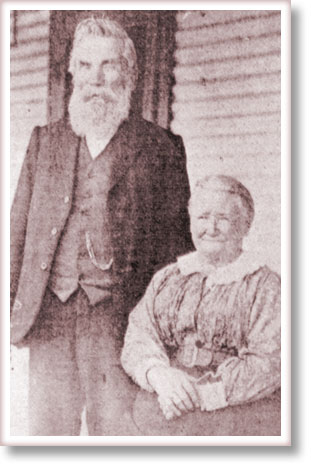 Mr. Thomas Leckie, who originally came out of Scotland to Victoria at the age of four, took up his lease on Sect. 56 Hd of Bews in 1897 and when the railroad arrived in 1906, was the only leaseholder still left in Lameroo. His wife, a good bush nurse, joined him once the original homestead was built.
Mr. Thomas Leckie, who originally came out of Scotland to Victoria at the age of four, took up his lease on Sect. 56 Hd of Bews in 1897 and when the railroad arrived in 1906, was the only leaseholder still left in Lameroo. His wife, a good bush nurse, joined him once the original homestead was built.
Mr. Leckie, once the railway arrived and he had access to good markets, improved his farm and increased his cropping area, and a new homestead was built in 1909.
In 1910 Mr. Leckie sold his property for £10 per acre, a record price, to the Needs family and bought land in tow where he set up a livery stable. He wife became a licenced midwife and used her home as a maternity home.
Mr. and Mrs. Leckie were well known for help and hospitality shown to new settlers arriving in the area.
Gallant Mallee Women
The women who made their home in the Mallee scrub were a stalwart and gallant band. Prior to leaving from wherever, it is very doubtful if they fully appreciated just what they were letting themselves in for. Certainly my mother did not, and she came some twenty years after Lameroo was proclaimed. The early years of privation, of bearing and rearing children in heat and dust with minimal amounts of water, were difficult to say the least for these newcomers to the area. A garden always took second place to the needs of horses and stock for the available water.
The lady I knew, living some forteen miles from Lameroo kept a small post office. The "office" was three sheets of corrugated iron for a roof. A 6ft x 6ft area enclosed with sewn together fertilizer bags housed a packing case desk. Stamps and money were kept in tobacco tins.
The same lady milked her cows tethered to mallee trees. She helped her husband, who had a partially withered leg, by harnessing horses, cutting chaff, carting hay and keeping house. While her case may well have been extreme, most farm wives worked alongside their men; manual labour was the norm.
Many young women who came to the area were school teachers, just out of college. They were, of course, very popular with the young men. As time would tell, these women had an immense impact on the educational standards of our district. Together with the nurses from our hospital, they encouragd a high standard of education for their children. The old saying of "educate a women and you educate a family" certainly rang true in our district.
Education relied on small one-teacher schools, each about six miles (8 km) apart, so each child had no further than about 5km to travel. For the most part the teachers were young single women, boarded by a nearby family. The town school had several teachers and even boasted a higher primary class. this school eventually becam Lameroo Area School which was established in 1944.
Stories from the SA Dryland Trail
CWA
The women of the early times had a tremendously softening effect on the lives of their men, bringing a touch of finesse to a very hard environment and rough living conditions. I myself grew up in very primitive surroundings but, poor as our furniture and amenities were, we always had a starched and ironed white tablecloth for Sunday lunch, and if we had visitors, matching serviettes.
The formation of the CWA (Country Women's Association) was a monumental milestone in the lives of the Mallee women. Our branch opened in August 1939, a public organisation embracing all women and working for the universal good of the community. Social and physical probems werre for teh first time being addressed and women felt their voice was at last being heard.
Recreation and Community
The social life of early times was very different to what is today regarded as the norm. In the beginning, playing fields were just a corner of a paddock fenced off - a rough oval shape marked out with a plough furrow. Tennis courts were an area cleared of weeds marked out with lines in the dirt or, at best, marked with lime wash. Several sports days were a yearly fixture. These consisted of running races, tug-o-war, stepping the distance, a rooster chase or maybe a "catch the greasy pig" and always followed by a "high tea". Strangely enough, the modern barbecue did not occur. Sunday always meant going to church and was a truly family affair. It was one time when all the family were together. At sports - football and tennis - sexes and children each seemed to go their own way. The Lutheran Church was a bit different. Here men and adolescent boys sat on one side, women and girls on the other. Men always went to communion first and women last. These fashions lasted until the 1950s. Following church, inter-family visits were usual. Lunch, a walk around, maybe a buggy ride round the farm, passed the afternoon. If someone had a piano or organ, a time of singing took place.
Progress in the Region
The second half of the century began on a very high note. With World War II over, business was booming, weather conditions were kind, stock and grain prices were high. Farm buildings were springing up afresh. As taxation was biting, farmers and town business people were spending on capital assets. This burst of propserity lasted to the end of the sixties.
Two very noteworthy events occured in the late 50s and 60s, namely the bulk grain silo (wheat) open in Lameroo for the 1959-60 grain harvest. The first grain silo outside of Port Adelaide in the Eastern Division, it was the beginning of many. The barley silo opened in 1964.
In 1965 ETSA power was connected to rural users by means of single wire earth return power lines. This event did much to boost the amenities of all rural folk, farm and town dwellers alike. Prior to ETSA power, most farms had their own 32 volt power plant, but these lacked the ability to provide hot water, cooking, TV, refrigeration, air-conditionng etc.
The seventies brought a levelling out in the grain prosperity, but sheep breeding (Merino) reached its peak and Lameroo came to have one of the foremost "off shears" sales in the State. Easy access to interstate markets plus quality stock had much to do with this aspect.
The eighties brought a restless urge to the Mallee; people were selling out, looking to a golden future on the rich red plains of Queensland. However, for many this was to become a mirage and their dreams of rich rewards were not to be accomplished.
The nineties brought what can only be described as a revolution to the area. Our underground wealth in the shape of artesian water was being utilised to grow vegetables - potatoes, carrots and onions. These new industries were being exploited by New Zealanders looking for cheap land and water. To this time the revolution continues with the establishment of olive plantations and pistachio nuts. For how long this can continue, no one is quite sure. The underground aquifers that hold our water will be the measure of this trend.
While the irrigation revolution was taking place, another was also in progress. The addition of new, and to our area, exotic crops were being grown under dryland conditions. Canola, beans, lupins, vetch and peas are now being grown on a regular basis, as well as experimental planting of chick peas and lentils. These new crops have led to continuous cropping acting as break crops for wheat, barley and triticale.
Lameroo, the town, has had its own turn of fortune. Now green lawns and solid homes have taken the place of tin houses and the dust or mud of the beginning years. Most of the good life has arrived, with lawned playing fields, a consolidated school catering to Year 12 education, churches and a well equipped hospital with visiting surgions, day care, outreach facilities and ambulance transfers by road or air.
Rail service continues, but has been down graded to freight. Trains only run during grain harvest or at such times as the grain silos need emptying. Several secondary industries make Lameroo their base. Agribusiness mix and prepare stockfeed additives or intensive livestock raising and export to all Australia and New Zealand. F.A. Miller & Son make conveyors for grain and dry flowable materials and export to all Australia and some overseas countries. Several other small industries are also quite unique.
We are, I believe, a very caring community and we look forward to the new millenium with hope and pride. We believe "We've done us proud".
A more detailed history of Lameroo and district can be found in "Pioneers & Progress" by Alan Jones.
Things to see and do
Dolly’s Golden Rain Tree Crafts and Heritage houses the museum – a great place to learn about the history of the town and its surrounding areas with the outback dunny exhibit a must see! Then be sure to browse for hand made gifts in the craft shop and, perhaps, sample the delicious home-made scones.
Ngarkat Group of Conservation Parks – features 270,000 hectares of unspoilt natural habitat and is home to 2WD accessible picnic sites and walking trails, 4WD tracks and an abundance of native wildlife. Visit, or phone, the National Parks office at Lameroo for information.
Dolly’s Golden Rain Tree
Crafts & Heritage
Lameroo Craft Shop, District Historical Society Museum & Visitor Information Centre
45 Chandos Terrace (Mallee Highway)
Lameroo SA 5302
Phone: (08) 8576 3699
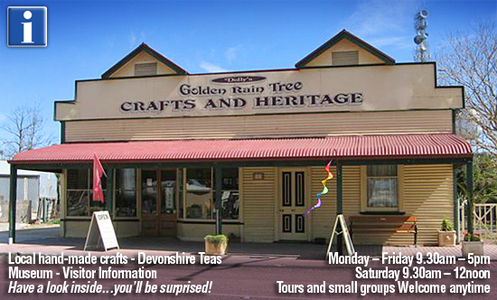
Browse through the beautifully kept shop which is stocked with an ever changing range of locally made quality craft, country cooking, sewing, knitting, art, woodcraft and souvenir lines, then enjoy morning or afternoon tea and a leisurely stroll around the museum.
Devonshire Teas
Devonshire Teas are available at all times and a variety of catering options can be offered to suit visit times and visitor numbers. Seating is available indoors and outdoors in the Golden Raintree Garden and the building is easily accessed, wheelchair and pram friendly, all under one roof.
Building History
Erected in 1911 the building was designed as a shop and dwelling. It was first used as a green grocery and then a saddler and leatherworker. The next occupant, besides mending harness, sold push bikes and motorcycles. The building then became a private home until converted for its current use.
Craft Shop
The Craft Shop has an excellent array of well priced and mostly locally made items for sale, including cakes, biscuits, jams and sauces, decorated tea towels, cushions, toiletries, cards, toys, jewellery, baby items and souvenirs just to name a few.
Tourist Information Centre and Museum
The Tourist Information Centre and Museum reflects early settlement of the area. There is a replica of an early Community Hall, Lutheran Chapel, Post Office, Bank and Shops as well as displays showing the Blacksmith, Farming, Mechanical and other aspects of life in a small town. Almost all the items on display in the museum have been donated and/or collected within the Lameroo area. Dolly’s Golden Rain Tree Crafts & Heritage is managed by Craft Club Members and Lameroo & District Historical Society Volunteers.
OPEN
Monday – Friday 9.30am – 5pm
Saturday 9.30am – 12noon
Entrance to the Museum is by gold coin donation
Tours and small groups welcome anytime
Bookings are appreciated for coaches due to staffing arrangements. Weekend, public holidays and after hours tours will be arranged by appointment.
Emergency Services
Ambulance: 000
Police: Lameroo (08) 8576 3010
Lameroo Hospital: (08) 8576 4600
Pinnaroo RAA: (08) 8577 8256
-
Dolly's Golden Rain Tree
Crafts & Heritage
45 Chandos Tce, Lameroo SA 5302
Phone (08) 8576 3699
Open: Mon-Fri 9.30am - 5pm
Sat - 9.30am - 12 noon - Border Track and Parks Information (SA)
Mallee District National Parks and Wildlife SA Lameroo Office
for Ngarkat, Billiatt, Karte and Peebinga Parks
Ph: (08) 8576 3690
Victorian Parks – Phone 131 963 -
Buses to Lameroo
Murray Bridge Passenger
Service from Adelaide to Pinnaroo Mondays to Friday Phone (08) 8212 1777 for more information.







